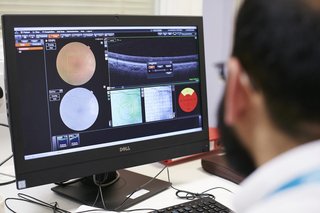AI Imaging: What we do
Artificial intelligence (AI) technologies applied to imaging, such as cancer screening, are among the most advanced uses of AI in healthcare. AI has the potential to transform the prevention, early detection and treatment of diseases, helping the NHS to provide better care and faster access to treatment.
-
National COVID-19 Chest Imaging Database (NCCID)
Find out more about this database, how we ensure the safety of patient data, and how to get involved in contributing or accessing data.
-
AI Deployment Platform (AIDP)
Find out more about the AI Deployment Platform, its vision and the latest updates on the pilot.
At the NHS AI Lab, our imaging team is working to develop and support the systems that will enable AI to achieve its potential by creating a user-friendly route to getting the best AI into use in the NHS.
Our work aims to:
- improve access to high-quality imaging data
- increase the speed and accuracy of diagnosis
- provide developers with safe access to NHS data sets to test and validate their AI tools
- ensure that the data-driven technologies created are the most beneficial solutions for patients
- create an environment where the most successful AI technologies can be easily procured and used by hospitals.
- increase the development and deployment of AI innovations.
Providing NHS data sets
To develop, train and test AI products, it is essential to have access to large and high-quality data sets that are representative of the UK population. One of the challenges for AI innovation is the difficulty in accessing data that is of sufficient size and quality to support development.
The COVID-19 pandemic created an urgent need for chest imaging data to understand the severity of the condition and provide direct patient care. Data that could be used for research into the virus and its treatment.
To support the development of technology that would help patients with the virus, we created a National COVID-19 Chest Imaging Database (NCCID) and are now looking to extend the scope of this data to include a wider range of medical images in a National Medical Imaging Platform (NMIP).
The benefits of AI in Imaging
AI is already helping doctors and other healthcare workers to screen more efficiently for some diseases, including cancer. The ability of AI solutions to identify potential areas of concern in an image more quickly and relentlessly than a human, is helping the NHS to recover from the backlog of patients caused by the pandemic.
- Read this example about the breast cancer screening tool, Mia, which analyses mammograms.
The NHS has set itself ambitious targets in its Long Term Plan to improve people’s access to quality care and treatment wherever they live in the country and to improve the outcomes for people diagnosed with the biggest killers, like cancer and heart disease.
It is our ambition to ensure that the potential for imaging AI is supported in the UK, to give the NHS the best chance of achieving its goals and saving or improving even more lives.
-

How patient data is used in the NCCID
There is huge value in the use of patient data to enable innovation in healthcare. This is how we are safeguarding patient data.
-

Case study: SMART box
Boosting data collection to the National COVID-19 Chest Imaging Database, this SMART box is delivering regional data with one simple installation.